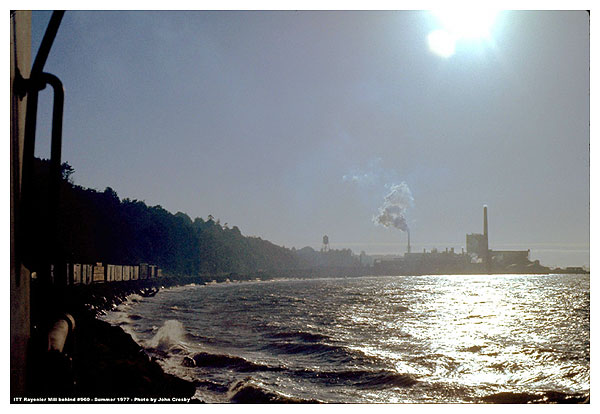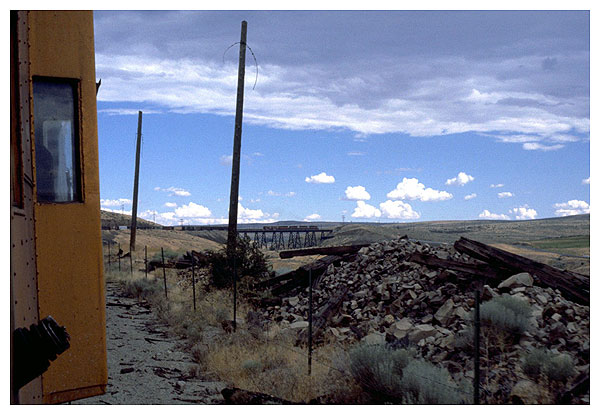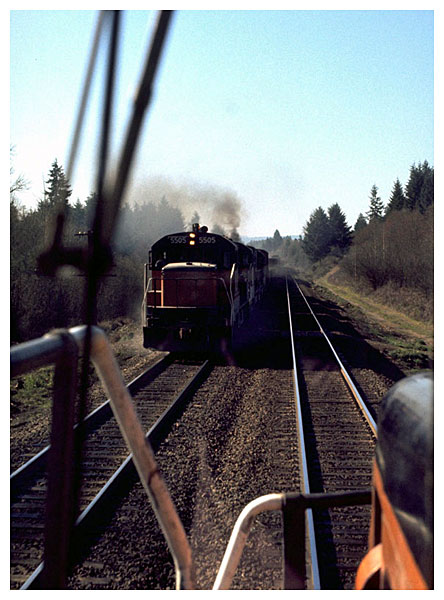INTRODUCTION
This website consists of a continuing series of photographic essays and personal memorials (more to be added from time to time) of my time in train service on the Coast Division of the Chicago, Milwaukee, St. Paul & Pacific Railroad, October 1975 through August 1978. In this short period, I was fortunate to work in almost every operating environment available to the geographic reach of my seniority district, including Seattle Yard, Tacoma Yard, Everett Yard, Bellingham Yard, Port Townsend switch job, Trains #200-6 (Tacoma to Othello), Trains #900-3 (Tacoma to Portland), Trains #904-5 (Tacoma to Bellingham), Trains #946-7 (Snoqualmie Turn/Everett Turn), Trains #948-9 (the Valley Owl), Trains #950-1 (Raymond Turn), Trains #952-953 (Sumas Local), Trains #954-5 (Hoquiam Turn), Trains #960-1 (Port Angeles Local), Trains #964-5 (Mineral Turn), Trains #966-7 (the Morton Local), Trains #980-981 ("WAM" export logs, Chehalis to Tacoma), Trains 982-3 (Chehalis Local), and various work trains and wreckers.

View West - Port Angeles Local - June 1977I worked three years for the Milwaukee Road, then three years for her chief competitor, Burlington Northern, Inc. Writing now in March of 2004, I am looking back over the span of some 26 years. And this through the filter of three years at the B.N. So while I try to get it right, some of what I write might be considered in the realm of historical fiction.

View East, Extra East's Power crosses Renslow Trestle over Interstate 90, Kittitas CountyThe Milwaukee Road, who billed herself as "America's Resourceful Railroad," was that and more. Her innovations were legion. Besides building the best engineered and most modern of the U.S. transcontinentals, the Milwaukee was the only major western railroad to have extensive mainline electrification. But those electrics do not appear in this website; they were before my time. Electrification in my district ended in 1972, I missed the electrics by three years.

View South, #901 meets #900 on Napavine Hill, Lewis CountyBut there was plenty else that made the Coast Division like no other: the mix of nineteenth century branch line log trains and modern mainline freight road operations; the capital investment in tunnel modification to accommodate modern tri-level auto carriers; the use of compensated curves and grades on the mainline; the Puget Sound barges and unique marine interchange with the British Columbia Railway at North Vancouver; an unusual mix of trackage rights over B.N. and Union Pacific routes; three "enclave" locations not contiguous to the Milwaukee Road proper, one of which was not contiguous to any railroad at all; mountain operations with well engineered, steady 2.2% mainline grades, in juxtaposition to a grueling 4% branch line grade over which operated four daily mainline-style heavy tonnage Portland trains (and this in urban Tacoma yard limits); lo-control "slaved" locomotive operations; a separate U.T.U. labor agreement that became the model for the future of labor relations in the industry; and a "shadow" network almost as extensive as the Burlington Northern, yet somehow remote and "undiscovered."
- John Crosby, Milwaukee Road Trainman
COAST DIVISION
SEATTLE YARD- Survivin' the Night
- Puget Sound Barges
- Switchin' & Trampin'
- Flat Switching
- Black River Yard & The P.C.R.R.
- Road Extra Board
- Tacoma Roundhouse
- Tacoma Junction
- Joint Line: Superiority of Trains
- Joint Line: Automatic Block Signals (ABS)
- Mainline: Othello
- Mainline: Extra 194 West
- Mainline: Extra 156 East
- Mainline: Beverly Depot
- Mainline: Columbia River Bridge, Boylston Tunnel, Renslow Trestle
- Mainline: Snoqualmie Pass
- Mainline: Cle Elum
- Mainline: Work Trains and Wreckers
- South Line: Rule 99 Territory
- Burlington Northern Pacific Division Third Sub: Centralized Traffic Control (CTC)
- Portland Trains
- Hoquiam Turn
- Tacoma and Eastern Railway (12th Sub): Mineral Turn
- Tacoma and Eastern Railway (12th Sub): Morton Local
- Olympic Peninsula (14th Sub): Port Angeles to Portland
Join the Milwaukee Road Historical Association and MilWest